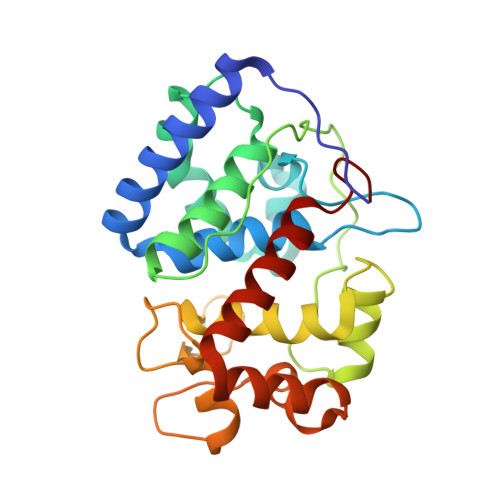Proton Delivery to Ferryl Heme in a Heme Peroxidase: Enzymatic Use of the Grotthuss Mechanism.
Efimov, I., Badyal, S.K., Metcalfe, C.L., Macdonald, I., Gumiero, A., Raven, E.L., Moody, P.C.E.(2011) J Am Chem Soc 133: 15376
- PubMed: 21819069
- DOI: https://doi.org/10.1021/ja2007017
- Primary Citation of Related Structures:
2Y6A, 2Y6B - PubMed Abstract:
We test the hypothesized pathway by which protons are passed from the substrate, ascorbate, to the ferryl oxygen in the heme enzyme ascorbate peroxidase (APX). The role of amino acid side chains and bound solvent is demonstrated. We investigated solvent kinetic isotope effects (SKIE) for the wild-type enzyme and several site-directed replacements of the key residues which form the proposed proton path. Kinetic constants for H(2)O(2)-dependent enzyme oxidation to Compound I, k(1), and subsequent reduction of Compound II, k(3), were determined in steady-state assays by variation of both H(2)O(2) and ascorbate concentrations. A high value of the SKIE for wild type APX ((D)k(3) = 4.9) as well as a clear nonlinear dependence on the deuterium composition of the solvent in proton inventory experiments suggest the simultaneous participation of several protons in the transition state for proton transfer. The full SKIE and the proton inventory data were modeled by applying Gross-Butler-Swain-Kresge theory to a proton path inferred from the known structure of APX. The model has been tested by constructing and determining the X-ray structures of the R38K and R38A variants and accounts for their observed SKIEs. This work confirms APX uses two arginine residues in the proton path. Thus, Arg38 and Arg172 have dual roles, both in the formation of the ferryl species and binding of ascorbate respectively and to facilitate proton transfer between the two.
Organizational Affiliation:
Department of Chemistry, Henry Wellcome Building, University of Leicester, University Road, Leicester LE1 7RH, England.
















